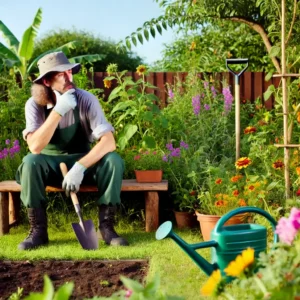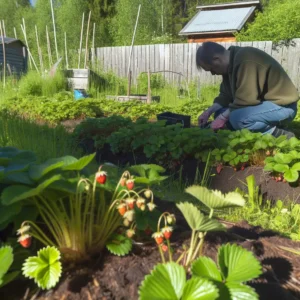Gardening has long been cherished as a healthy and mind-refreshing pastime, offering a chance to connect with nature and create something beautiful. Among the multitude of gardening pursuits, few are as enchanting and rewarding as cultivating a vibrant flower garden. There’s something inherently magical about watching colorful blooms burst forth from the earth, filling the air with their sweet fragrance and bringing joy to all who behold them.
Whether you’re a seasoned gardener with years of experience or a beginner enthusiast eager to place your feet into the world of horticulture, creating a flower bed and starting a flower garden is a journey worth embarking on. In this guide, we’ll jump into the process of transforming a patch of earth into a blooming haven of beauty and tranquility. From How to Make a Flower Bed, selecting the perfect location to choosing the right flowers and caring for them throughout the seasons, we’ll provide you with all the knowledge and inspiration you need to kickstart your own floral paradise.
This is How to Make a Flower Bed

1. Choosing the Right Location
Selecting the ideal location for your flower bed is the crucial first step in creating a successful garden. The amount of sunlight your chosen spot receives is perhaps the most critical factor to consider, as most flowering plants require ample sunlight to grow. Spend some time observing the sunlight patterns in your yard throughout the day, paying attention to areas that receive at least six hours of direct sunlight.
Additionally, factors such as soil quality and drainage should be taken into account. Flowers prefer well-draining soil rich in organic matter, so avoid areas prone to waterlogging or compacted soil. By carefully assessing these environmental factors, you can ensure that your flower bed has the best possible chance of success from the outset.
2. Designing Your Flower Bed
Once you’ve pinpointed the perfect location for your flower bed, it’s time to unleash your creativity and design a layout that reflects your vision and style. Consider the overall size and shape of your garden space, as well as any existing landscaping features that you want to incorporate or work around. Traditional rectangular beds are a classic choice, but don’t be afraid to think outside the box and experiment with curved or irregular shapes for added visual interest.
When designing your flower bed, think about creating focal points and pathways that will draw the eye and invite exploration. Incorporating elements such as decorative rocks, garden ornaments, or eccentric sculptures can add personality and charm to your garden design, making it truly unique.
3. Preparing the Soil
Preparing the soil is a vital step in laying the foundation for a healthy and growing flower garden. Before you start planting, take the time to test the pH level of your soil to determine its acidity or alkalinity. Most flowering plants prefer slightly acidic soil with a pH level between 6.0 and 7.0, so amend the soil as needed to achieve the optimal pH balance.
Adding organic matter such as compost, aged manure, or peat moss can improve soil texture, fertility, and drainage, creating a hospitable environment for your plants to grow. Use a garden fork or tiller to loosen the soil to a depth of at least 12 inches, breaking up any clumps and removing rocks, roots, and wastes along the way. By preparing the soil thoroughly before planting, you’ll provide your flowers with the best possible start and set them up for success in the seasons to come.

4. Selecting Flowers
With your flower bed prepared and ready to go, it’s time to turn your attention to selecting the perfect flowers to populate your garden. When choosing flowers, consider factors such as your climate, local growing conditions, and the specific requirements of each plant species. Aim for a diverse mix of flowers that will provide continuous blooms throughout the growing season, adding colour and fragrance to your garden from spring through fall.
For beginners, opt for low-maintenance flower varieties that are easy to grow and require minimal care. Some popular options include marigolds, petunias, zinnias, sunflowers, and cosmos, all of which are known for their vibrant colours and prolific blooms. Mix and match different flower varieties to create a visually stunning display that reflects your personal taste and style, and don’t be afraid to experiment with different combinations until you find the perfect blend.
5. Planting Your Flower Bed
With your flower selection finalised, it’s time to roll up your sleeves and get your hands dirty as you plant your chosen flowers in your freshly prepared flower bed. Before you begin, take a moment to visualise the layout of your garden and plan out where each flower will go, taking into account factors such as height, colour, and blooming time. If you’re transplanting seedlings or bedding plants, carefully remove them from their pots, being mindful not to disturb the roots, and plant them at the appropriate depth in the soil.
For seeds, follow the planting instructions on the seed packets, ensuring that they are sown at the correct depth and spacing for optimal germination. After planting, water your flowers thoroughly to help them settle into their new home and establish strong root systems. As you work, take care to handle your plants gently and avoid compacting the soil, which can hinder root growth and drainage. With each plant carefully placed, your flower bed will begin to take shape, promising a season of beauty and abundance ahead.
6. Watering and Maintenance
Proper watering and maintenance are essential for the health and vitality of your flower bed. While flowers have varying water needs depending on their species and environmental conditions, a general rule of thumb is to water deeply and consistently, ensuring that the soil remains evenly moist but not waterlogged. During hot and dry periods, your flowers may require more frequent watering to prevent wilting and dehydration. Mulching around the base of your plants can help retain moisture in the soil, suppress weeds, and regulate soil temperature.
Be sure to monitor your flower bed regularly for signs of moisture stress, such as hanging down leaves or dry soil, and adjust your watering schedule accordingly. In addition to watering, regular maintenance tasks such as weeding, deadheading, and fertilizing are essential for keeping your flower bed looking its best. Remove weeds promptly to prevent them from competing with your flowers for nutrients and water, and deadhead spent blooms to encourage continued flowering throughout the season. Fertilise your flowers as needed with a balanced fertilizer to provide them with the nutrients they need to grow. By staying on top of these maintenance tasks, you’ll ensure that your flower bed remains healthy, vibrant, and beautiful year-round.

7. Dealing with Pests and Diseases
While flower gardens are a delight to behold, they are also vulnerable to pests and diseases that can destroy your plants if left unchecked. Common garden pests such as aphids, snails, slugs, and caterpillars can damage leafage, stunt growth, and transmit diseases to your flowers. Keep an eye out for signs of pest infestations, such as chewed leaves, holes in leaves, or sticky residue on plant surfaces, and take appropriate measures to control them. Consider using organic pest control methods such as handpicking pests, introducing beneficial insects like ladybugs or lacewings, or using natural repellents such as neem oil or insecticidal soap.
In addition to pests, flower gardens are also vulnerable to diseases such as powdery mildew, botrytis, and root rot, which can cause wilting, yellowing leaves, and other symptoms. Practise good garden hygiene by removing dead or diseased plant material ASAP to prevent the spread of diseases. Proper spacing, adequate air circulation, and proper watering practices can also help prevent the development of fungal diseases. By staying vigilant and taking proactive measures to protect your plants, you can keep your flower garden healthy and prosperous year after year.
8. Seasonal Care and Bloom Management
As the seasons change, your flower garden will require different care and attention to keep it looking its best. Throughout the growing season, continue to monitor your flower bed for signs of growth, flowering, and any issues that may arise. Trim your flowers as needed to remove spent blooms, dead or damaged leaves, and overcrowded stems, which will promote new growth and encourage continued flowering. Deadheading flowering plants regularly can also help prolong the blooming season and maintain a tidy appearance.
In addition to trimmimg and deadheading, consider dividing overcrowded perennials every few years to regenerate the plants and prevent them from becoming overcrowded. This process involves carefully digging up the plant, dividing the root ball into smaller sections, and replanting them in fresh soil. By dividing perennials, you’ll not only ensure the health and vitality of your plants but also create new opportunities for expanding and diversifying your flower garden. With proper care and attention to seasonal maintenance tasks, your flower bed will continue to improve and delight your senses year after year, providing you with endless enjoyment and beauty.
Summary
In this comprehensive guide, we’ve tried to explore the essential steps involved in making a flower bed and starting a flower garden. From selecting the right location and designing your flower bed to planting, watering, and maintaining your flowers, we’ve covered everything you need to know to create a stunning garden sanctuary. Following these guidelines and putting your passion for gardening into action, you can cultivate a beautiful and flourishing flower garden that will delight your senses and uplift your spirits.
FAQ
Q1: How much time does it take to establish a flower garden?
- Establishing a flower garden can vary depending on factors such as the size of the garden, the types of flowers chosen, and local climate conditions. Generally, it can take several weeks to prepare the soil, select and plant flowers, and establish a watering and maintenance routine.
Q2: What are some low-maintenance flower options for beginners?
- Some low-maintenance flower options for beginners include marigolds, petunias, zinnias, sunflowers, and cosmos. These flowers are easy to grow, require minimal care, and provide vibrant blooms throughout the growing season.
Q3: How often should I water my flower bed?
- The frequency of watering your flower bed will depend on factors such as weather conditions, soil type, and the specific water needs of your plants. In general, water deeply and consistently, ensuring that the soil remains evenly moist but not waterlogged.
Q4: How can I attract pollinators to my flower garden?
- To attract pollinators such as bees, butterflies, and hummingbirds to your flower garden, plant a variety of nectar-rich flowers in different colours, shapes, and sizes. Avoid using pesticides that can harm pollinators, and provide shelter and habitat for them to advance.
Q5: What should I do if my flowers are not blooming as expected?
- If your flowers are not blooming as expected, consider factors such as insufficient sunlight, poor soil quality, or improper watering and maintenance. Make adjustments as needed to address any issues and provide optimal growing conditions for your plants.









2 thoughts on “How to Make a Flower Bed and Start a Flower Garden like a Pro”